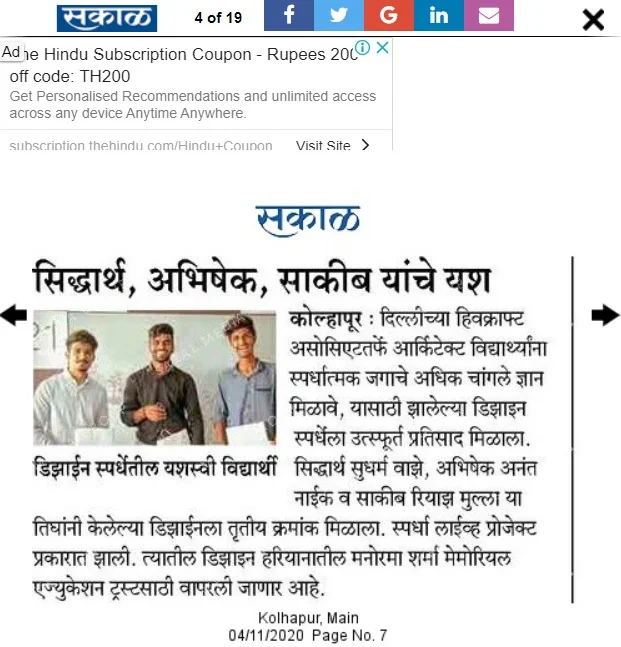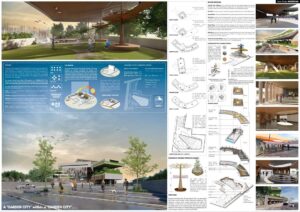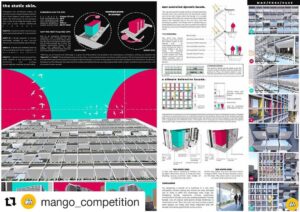‘sas.’ wins Hivekraft School Design Competition – A live Project in Haryana
Innovating the Future of Education: Discover the Groundbreaking Ideas from the Hivekraft School Design Competition
21th October 2020:

The Hivekraft School Design Competition, a significant event in the field of architectural design, saw an outstanding performance by Siddharth Waze, Abhishek Naik, and Saqib Mulla. Their innovative and thoughtful design won them the Third Prize in this live project competition, which was organized by Hivekraft in association with Studio Arc.s from Delhi. The competition posed a unique challenge by allowing the winning designs to be implemented on-site in Haryana, making the competition not just an academic exercise but a tangible opportunity for real-world impact.
About the Hivekraft School Design Competition
The Hivekraft School Design Competition aimed to tackle the modern challenges faced by school environments. Today’s schools often struggle with issues of overcrowded spaces, lack of engaging learning environments, and an overwhelming disconnect between children and the spaces they inhabit. The goal of the competition was to rethink how educational spaces can be reimagined to foster collaboration, creativity, and comfort for both children and adults alike. The competition received around 100 entries, and the best three were selected for potential implementation on-site.
The Hivekraft School Design Competition not only pushed participants to rethink the conventional school design but also encouraged them to integrate features that would be sustainable, functional, and adaptable. The live nature of the Hivekraft School Design Competition made it all the more exciting and relevant, as the winning designs would eventually become a part of a community, positively impacting the lives of children, teachers, and other stakeholders.
The Design Philosophy of the Winning Team
The design submitted by Siddharth Waze, Abhishek Naik, and Saqib Mulla focused on the critical issue of making school spaces more engaging, interactive, and beneficial for the people who use them. Their approach to the design emphasized the need for a balance between functionality and aesthetic appeal, as well as a focus on the well-being of students and staff. They addressed the increasing concerns of traditional school layouts that can feel confining and uninspiring. Their proposal sought to create a design that would encourage interaction, enhance creativity, and provide a conducive learning environment.
The team’s design zoning was crafted in direct alignment with the client’s need to create a space that would not only serve educational purposes but also generate revenue from external public use. By allowing areas of the school to be utilized by the local community, the design maximized the space’s potential while contributing to the broader social and economic needs of the area.
The project was designed to be scalable and adaptable, capable of adjusting to the dynamic needs of a growing school population. The idea was to create zones within the campus that could be used for different purposes: classrooms for learning, common areas for socializing and interaction, and flexible spaces that could adapt to a range of activities. The school’s design would be responsive to both students’ educational needs and the practical concerns of maintaining a functional, sustainable facility.
Key Aspects of the Design Presentation
The design presentation submitted by the winning team encompassed several crucial elements:
Conceptual Framework: The design concept centered around creating a space that fosters a sense of belonging and community. The layout aimed to connect people in different parts of the school through a network of open spaces, natural light, and fluid pathways that encourage movement and collaboration.
Design Intervention: The winning team introduced various design interventions that sought to address specific challenges within the existing educational environment. These interventions were innovative and included the integration of green spaces, the use of sustainable materials, and multi-functional rooms that could accommodate a wide range of activities.
Construction Stages and Process: The design proposal also included detailed ideation of the construction stages and processes. This aspect was vital, as it highlighted how the project could be built in phases, ensuring that the construction timeline was realistic and cost-effective. The team presented a clear and achievable plan for how the design could evolve over time while maintaining its integrity.
The Jury and Award Ceremony
The Hivekraft School Design Competition concluded with a live Zoom ceremony held on October 20, 2020. This was an exciting moment for the entire architecture community, as the winning designs were revealed, and the architectural community had the chance to celebrate the success of the top entries. The competition’s esteemed jury included prominent figures in the world of architecture:
- AND Studio, Delhi
- Studio Arc.s, Delhi (collaborators of the competition)
- Humming Tree, Kerala
- Karan Desai, Mumbai
- Shanmugam Associates, Chennai
- The Purple Ink Studio, Bangalore
These respected jurors brought their wealth of experience and vision to the judging process, ensuring that the most impactful, innovative, and sustainable designs were selected for recognition.
Conclusion: Impact and Future of School Design
The Hivekraft School Design Competition not only showcased exceptional architectural talent but also placed a spotlight on the future of educational spaces. This prestigious competition encouraged architects to rethink traditional designs and move toward more adaptive, inclusive, and sustainable solutions. For Siddharth Waze, Abhishek Naik, and Saqib Mulla, their Third Prize win in the Hivekraft School Design Competition is a testament to their creativity and forward-thinking approach to school design. Their project demonstrates that architecture has the power to shape how people experience and interact with the world, especially in critical spaces like schools.
As the design moves closer to implementation in Haryana, it will undoubtedly serve as an inspiring example of how the Hivekraft School Design Competition has driven innovative thinking in school architecture. Such projects highlight the evolving field of architecture, embracing new ideas and solutions for a better future, ultimately improving educational environments for children, teachers, and the local community.
Through the Hivekraft School Design Competition, architects have been empowered to redefine school architecture, paving the way for groundbreaking advancements in educational spaces.
Related Posts

‘Architecture Design Competition: International Facade Design Competition by Mango Architecture Conquered by SAS3Plus Architecture

sas. secured a spot in ‘TOP 25 ENTRIES’ at ‘The Master Studio’ by Archemello Competitions India.
